Over the past 2 years, I have read countless articles on this forum and watched most of Will’s videos (yeah, I’ve watched a lot of videos). The information and feedback was invaluable and made this project possible. The process to complete this project was educational (to say the least) and a lot of fun! Thanks to everyone for making this forum such a collaborative environment!
Here were the main objectives for this project:
Sheds (Pic2): Keter mini shed (29” x 55” x 67”) which holds inverter & batteries and large custom shed (8’ x 12’ x 8’) where the solar panels are installed. The Keter mini shed is framed inside to provide structure for the air conditioner install, inverter install, and the exterior AC electrical boxes. The Keter mini shed is primarily insulated with ¾” foam board (double layer for ceiling). Also, cement board was used as a mounting surface for the inverter and fuse holder.
AC Boxes (Pic3): AC input/output (AC4/AC5) from solar inverter and AC input/output (AC3/AC2) from house panel. Mainly used RV-style input/output boxes (GE & Midwest) except for the input to the house which uses a transfer switch (from Reliance).
Inverter & Batteries (Pic4): Using the Growatt inverter (IN1) with the WiFi stick. Also, using communication between the EG4 battery (B2) and the Growatt inverter. After initial setup, the information from the WiFi stick has been very stable along with the battery to inverter communication. Initially started with just 4 Lion Energy batteries (B1) and then added the EG4 battery after a few months.
DC Wiring (Pic5): Used the Victron fuse holder with included busbar (DC2) so that a separate busbar would not be needed. Also, placed both negatives directly on the Victron shunt (DC3) given the bulk of the connector. Created custom brackets to install the MidNite Solar breaker (DC1). NOTE: MidNite Solar recommends only using their breakers in their breaker boxes. Lastly, created a custom device (large red button) to pre-charge the inverter capacitors. My understanding is the EG4 battery has a pre-charge so my custom device should not be needed when the EG4 battery is connected (and turned on first).
Combiner (Pic6): Used a solar combiner box from MidNite Solar (DC5) along with four 20A breakers and one 63A GFP breaker. Also, installed a surge protector from MidNite Solar. The diagram also shows four 25A inline fuses (for each pair of solar panels) which are installed under the solar panels.
Solar Panels (Pic7): Installed 8 Rec Alpha 365W solar panels (SP1) on the shed using IronRidge rails and footings. The shed is anchored using 6 ground anchors buried ~3 feet deep and bolted to the shed skids with wire rope.
Aerial (Pic8): The solar panels on the large shed are attached to the inverter in the mini shed using ~40 feet of 6-AWG THWN-2. The solar panels are facing east and west since that was the original orientation of the large shed. The solar panels have a clear view of the southern sky throughout the day.
Solar Production (Pic9): The complete system has been running for about 1 year and has generated more than 3,100 kWh.
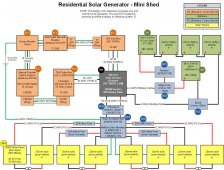
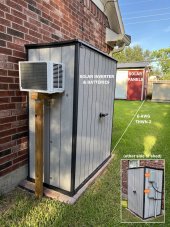
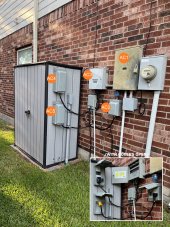


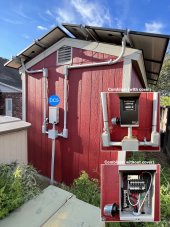
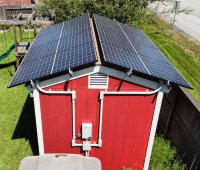

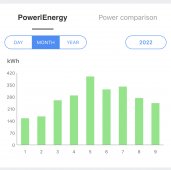
Here were the main objectives for this project:
- Create a system that could safely and easily connect and disconnect from the house electrical
- Create a system that could provide partial house backup and support limited house circuits (ongoing if needed)
- Create a waterproof/climate-controlled space to store inverter/batteries (outside the house and near the main panel)
- Install the solar panels on a shed (anchored) that sits about 20 feet back from the house
- Inverter (Growatt SPF 3000TL)
- Battery (Lion Energy UT 1300) x 4
- Battery (EG4 LifePower4)
- Transfer Switch (Reliance R510A)
- Solar Panels (Rec Alpha REC365AA) x 8
- Solar Combiner (MidNite Solar MNPV6)
- Solar Panel Rails (IronRidge XR1000) x 4
- Mini Shed (Keter 17209457)
Sheds (Pic2): Keter mini shed (29” x 55” x 67”) which holds inverter & batteries and large custom shed (8’ x 12’ x 8’) where the solar panels are installed. The Keter mini shed is framed inside to provide structure for the air conditioner install, inverter install, and the exterior AC electrical boxes. The Keter mini shed is primarily insulated with ¾” foam board (double layer for ceiling). Also, cement board was used as a mounting surface for the inverter and fuse holder.
AC Boxes (Pic3): AC input/output (AC4/AC5) from solar inverter and AC input/output (AC3/AC2) from house panel. Mainly used RV-style input/output boxes (GE & Midwest) except for the input to the house which uses a transfer switch (from Reliance).
Inverter & Batteries (Pic4): Using the Growatt inverter (IN1) with the WiFi stick. Also, using communication between the EG4 battery (B2) and the Growatt inverter. After initial setup, the information from the WiFi stick has been very stable along with the battery to inverter communication. Initially started with just 4 Lion Energy batteries (B1) and then added the EG4 battery after a few months.
DC Wiring (Pic5): Used the Victron fuse holder with included busbar (DC2) so that a separate busbar would not be needed. Also, placed both negatives directly on the Victron shunt (DC3) given the bulk of the connector. Created custom brackets to install the MidNite Solar breaker (DC1). NOTE: MidNite Solar recommends only using their breakers in their breaker boxes. Lastly, created a custom device (large red button) to pre-charge the inverter capacitors. My understanding is the EG4 battery has a pre-charge so my custom device should not be needed when the EG4 battery is connected (and turned on first).
Combiner (Pic6): Used a solar combiner box from MidNite Solar (DC5) along with four 20A breakers and one 63A GFP breaker. Also, installed a surge protector from MidNite Solar. The diagram also shows four 25A inline fuses (for each pair of solar panels) which are installed under the solar panels.
Solar Panels (Pic7): Installed 8 Rec Alpha 365W solar panels (SP1) on the shed using IronRidge rails and footings. The shed is anchored using 6 ground anchors buried ~3 feet deep and bolted to the shed skids with wire rope.
Aerial (Pic8): The solar panels on the large shed are attached to the inverter in the mini shed using ~40 feet of 6-AWG THWN-2. The solar panels are facing east and west since that was the original orientation of the large shed. The solar panels have a clear view of the southern sky throughout the day.
Solar Production (Pic9): The complete system has been running for about 1 year and has generated more than 3,100 kWh.













